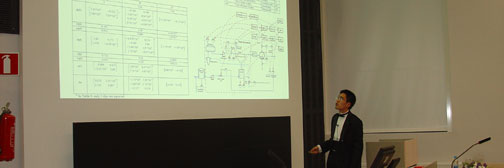| | Year 2001
Janne NäränenSimulating and analyzing the effects of refiner segments on TMP-process using a theoretical model
In the thesis a simulation model, called JAMA model, was used to simulate the effects of the refiner segments on the process conditions and pulp quality. The main object of this master’‘s thesis is to test how well the JAMA model can simulate the real thermomechanical pulping process, when refiner segment design parameters are changed. This was done by comparing the simulated process conditions with the measured ones. In addition to this another object is to clarify the mechanisms that cause the changes in the refiner process conditions and in pulp quality between different segments. This is done by using the basic physical terms given by the JAMA model.
In the litterature survey part of this study, the thermomechanical pulping process is introduced. The effects of the refiner segments and other factors on the process conditions and on pulp quality are explained. Also the basic principles as well as the balance equations of the JAMA model are introduced.
A mill scale test runs were performed in order to test the model. The refiner segment design parameters, whose effects were experimented in this work, were: the bar and groove width ratio, bar height, taper (the length of the refining zone), selective groove and number and place of dams. The process conditions and pulp quality parameters were measured on every trial.
It turned out that the JAMA model can simulate the effect of certain segment geometries fairly well at the qualitative level. In these cases measured and simulated process conditions changed to the same direction, when segment design parameters were changed. This was however depended on the segment design parameter in question. The effect of selective groove could not be simulated properly. In a quantitative level the simulations differed significantly from the measurements. Usually the changes were smaller in simulations compared to the measurements. One of the reasons for these differences was assumpted to be the fact that in most cases the disc gaps used in simulations differed significantly from the real disc gaps. This was due to the weak correlation between power consumption and disc gap in the model.
There seemed to be five different factors (relationships), given by the JAMA model, that could explain the differences in pulp quality parameters between different trials. It was found that usually high strength properties of fiber and low light scattering coefficient were related with some of the following: low fiber pressure, low volume fraction of fiber, high proportion of abrasion work or the fact that the power consumption moved towards the outlet. It was also found that short theoretical residence time in different balance volumes, especially where most of the energy is used, could be the main reason for low energy consumption or low freeness value. Another reason for this could be high proportion of collision work. The correlations between these five explanatory factors and measured pulp properties were usually the same in a qualitative level in all trials, which improved the reliability of these findings. The credibility of these findings was however reduced because the differences in the pulp properties were relatively small between certain trials and there were also difficulties with some of the measurements. Also the fact that the JAMA model could not simulate the effect of different segment geometries properly in a quantitative level makes the conclusions somewhat unreliable. However as a result of this work, many new ideas and hypothesis were born, which may be useful, when designing new more efficient segments.
Deprecated: strlen(): Passing null to parameter #1 ($string) of type string is deprecated in C:\WWWroot\Root\incs\5_theses\theses_new2010.php on line 248
This info last modified 27 Apr 2024 - contact webmaster
|

